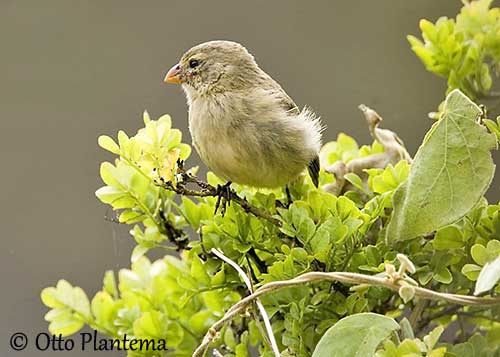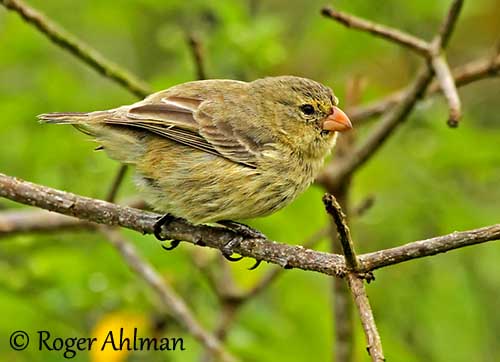
Fr: Géospize minuscule
All: Zwergdarwinfink
Esp: Pinzón de Darwin Chico
Ita: Fringuello arboricolo insettivoro piccolo
Nd: Kleine Boomvink
Sd: Mindre trädfink
Photographers:
Roger Ahlman
Pbase Galleries Peru and Ecuador
Otto Plantema
Trips around the world
Text by Nicole Bouglouan
Sources:
HANDBOOK OF THE BIRDS OF THE WORLD Vol 16 by Josep del Hoyo- Andrew Elliot-David Christie – Lynx Edicions – ISBN: 9788496553781
BirdLife International (BirdLife International)
Neotropical Birds – Cornell Lab of Ornithology
Small Tree-Finch
Camarhynchus parvula
Passeriformes Order – Thraupidae Family
Darwin’s Finches - Generalities
INTRODUCTION:
As its name implies, this species is largely arboreal. The Small Tree-Finch is an insect-eater. The tree-finches have paler plumage than ground and cactus finches, the other Darwin’s Finches. They also have sharper bill made primarily for grasping.
DESCRIPTION OF THE BIRD:
Biometrics:
Length: 11 cm
Weight: 11-16 g
The adult male of nominate race has greyish-olive upperparts with darker feather centres.
The underparts are buffy-white, with indistinct darker streaks on lower breast and flanks. The undertail-coverts are unstreaked buffy-white.
The head is blackish, forming a dark hood extending down to throat and breast.
The tiny rounded bill is black during the breeding season, and dull orange with dark culmen outside this period. The eyes are dark. Legs and feet are black.
The female is paler, with dull greyish-brown unstreaked upperparts and slightly streaked whitish underparts. The tail is brown. We can see two narrow grey-buff wingbars on the brownish upperwing.
The head is greyish-brown, with paler area above and below the eye.
The bill is dull orange with dark culmen. Legs and feet are blackish.
The immature male is similar to female but with blackish forehead, face and lower throat.

SUBSPECIES AND RANGE:
There are two subspecies.
C.p. parvulus (here described) is found on several islands in the Galapagos archipelago: Pinta, Fernandina, Isabela, Santiago, Rábida, Pinzón, Baltra, Santa Cruz, Sante Fe and Floreana.
C.p. salvini occurs on San Cristobal Island in SE Galapagos Islands. This one is slightly larger than nominate. It has longer bill but lacks the dark hood. The underparts are yellowish-buff and more strongly streaked.
HABITAT:
The Small Tree-Finch is an arboreal species, usually found in forested areas, cultivated areas with trees, and also in some parts of the drier zone where tall shrubs and other vegetation are growing.
This species can be seen at all elevations, from dry areas to highland wet zones, but it is usually common from and above the transition area.
CALLS AND SONGS: SOUNDS BY XENO-CANTO
The Small Tree-Finch utters a high-pitched double note “zee-tzee, zee-tzee” as song. This sound is related to the bill size.
BEHAVIOUR IN THE WILD:
The Small Tree-Finch feeds primarily on insects, small arthropods and caterpillars. It picks the preys from bark and leaves’ surface, but also bites through the bark to reach insect larvae.
However, during the dry season, it feeds on seeds, fruits, buds and occasionally takes nectar from flowers.
It forages in foliage and mainly above the ground, although it can be seen occasionally on the ground. It gleans insects from leaves and twigs, but also hangs from tips of branches, moving upside-down to reach preys from the vegetation.
The Small Tree-Finch is monogamous, and pairs with long-term pair-bonds are fairly common. During the breeding season, the male displays to attract a female. It builds a dome-shaped nest and displays outside this structure while singing. The female may accept both male and nest, but sometimes she rejects the nest, and the pair builds a new one. But both male and nest can also be rejected!
The females prefer the older males, able to build a well concealed nest than younger males. Such nests are protected from predators involving better breeding success.
The Small Tree-Finch is resident in its range. It only performs short flights.
REPRODUCTION OF THIS SPECIES:
The breeding season occurs during the hot wet season, when food resources are abundant.
The male builds a spherical structure with lateral entrance towards the top. The nest is built among the vegetation, with dry grasses, moss and lichens.
The female lays 3-4 whitish eggs with darker spots. She incubates during 12 days. The chicks fledge about two weeks after hatching.
The young birds are often preyed upon by the Short-eared Owl, and the adults are killed by the Galapagos Hawk, but the Lava Heron may take them too.
PROTECTION / THREATS / STATUS:
The Small Tree-Finch is common and widespread throughout its range. Its populations are suspected to be stable, and currently, this species is not globally threatened.
